Year of Recovery Well Underway for Commercial Jet Makers – Strong Vote of Confidence in 737 MAX
by J. Kasper Oestergaard, European Correspondent, Forecast International.
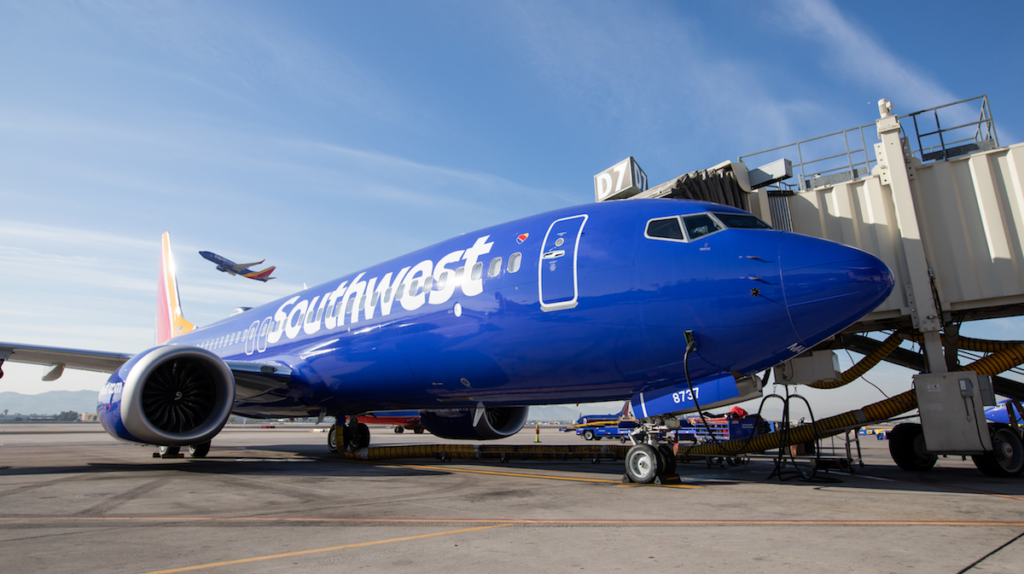
Boeing and Airbus delivered 77 and 125 commercial jets in the first quarter of 2021, compared to 50 and 122 deliveries, respectively, in Q1 2020. For the full year 2020, Boeing delivered 157 aircraft, compared to 380 and 806 in 2019 and 2018, respectively. In 2020, Airbus delivered 566 aircraft and won the deliveries crown for the second year in a row. Due to COVID-19, deliveries were down from 863 and 800 in 2019 and 2018, respectively. Airbus is expected to retain the deliveries crown for years to come due to the company’s comfortable backlog lead over its American rival. Prior to 2019, Boeing had out-delivered Airbus every year since 2012.
Following a more than challenging 2020 due to the COVID-19 pandemic, 2021 is expected to be a year of recovery for the two largest commercial plane makers. The past two years have particularly been challenging for Boeing, but things are now looking brighter. Orders and deliveries are on the rise and the 737 MAX has been cleared to return to the skies in much of the world except in China, the world’s second-largest market for commercial air traffic. China is still prohibiting the plane from flying and has not indicated when it will reverse course.
In Q1 2021, Boeing delivered 77 jets, including 63 737s (58 MAX / 5 NG), one 747-8, five 767s, six 777s, and two 787s. Production of the 737 MAX was suspended from January 2020 until the end of May that year, when Boeing announced it had commenced low rate production of the aircraft. Boeing continues to expect the 737 MAX production rate to gradually increase to 31 per month by early 2022, with further increases as market demand allows. Boeing has reduced the 787 production rate from 14 per month (rate at the start of 2020) to just five per month as of March 2021. Boeing has now moved all 787 final assembly to its facilities in Charleston, South Carolina.
In Q1 2021, Airbus delivered 125 jets, including nine A220s, 105 A320s (96 neo / 9 ceo), one A330, and 10 A350s. Prior to the COVID-19 pandemic, Airbus was targeting a 5 percent A320 rate increase to 63 jets per month from 2021, and was also discussing a further ramp-up with its supply chain that could have brought the production rate up to as high as 67 aircraft per month, or 804 per year, by 2023. This would have put the company within reach of a total of 1,000 jet deliveries per year. These plans have now been shelved. On January 21, 2021, Airbus released an updated production rate plan and now expects to increase A320 production from the current rate of 40 per month to 43 in Q3 and 45 in Q4 2021. This represents a slower ramp-up than the previously anticipated 47 aircraft per month from July. The A220 monthly production rate was increased from four to five aircraft per month by the end of Q1 2021. Widebody production rates will remain at current levels, with monthly production rates of around five and two for the A350 and A330, respectively. With only five A380s in backlog as of March 31, 2021, the end of the A380 program draws near. The last aircraft is expected to be delivered to Emirates in May 2022.
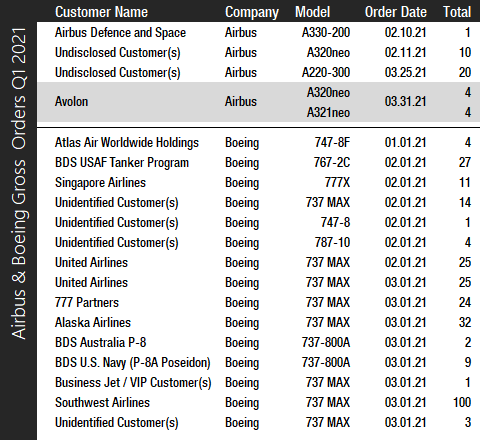
Turning to the Q1 2021 orders race, Boeing had a strong quarter and booked 15 orders for a total of 282 jets; however, the company also reported 213 cancellations, of which 190 were for the 737 MAX. The 282 gross orders included 235 737s (224 MAX / 11 NG), five 747-8s, 27 767s, 11 777s, and four 787s. The largest order was for 100 737 MAX 7s for Southwest Airlines. As part of the agreement, Southwest also converted 70 737 MAX 8 firm orders to MAX 7 firm orders and added 155 options for a mix of MAX 7 and MAX 8 aircraft. By the end of Q1 2021, Southwest had 337 unfilled orders in place for the 737 MAX. Other large orders in the first quarter of the year were United Airlines’ purchase of 50 737 MAX jets (two separate orders for 25 aircraft), Alaska Airlines’ order for 32 737 MAX 9s, and 777 Partners’ (a Miami-based private investment firm) order for 24 737 MAX 8s. Furthermore, the U.S. Air Force ordered 27 KC-46 tankers via Boeing Defense, Space & Security (BDS). Also, Singapore Airlines boosted the 777X program with an order for 11 aircraft. In 2020, Boeing accumulated a total of 184 gross orders and received 655 cancellations, for a total of -471 net new orders.
In Q1 2021, Airbus booked four new orders for a total of 39 jets and reported 100 cancellations. Orders included 20 A220s, 18 A320s, and one A330. Undisclosed customers ordered 20 A220-300s and 10 A320neos, Airbus Defence and Space ordered a single A330 MRTT tanker, and Ireland-based leasing firm Avolon placed an order for four A320neos and four A321neos. In 2020, Airbus accumulated 383 gross orders and received 115 cancellations, for a total of 268 net new orders – enough to win the orders crown for the second year in a row.
At the end of March, Airbus’ reported a backlog of 6,998 jets, of which 6,198, or 89 percent, were A220 and A320ceo/neo family narrowbodies. This is 727 aircraft below the company’s all-time backlog record of 7,725 aircraft set in January 2020. By the end of March 2021, Boeing’s backlog (total unfilled orders before ASC 606 adjustment) was 4,989 aircraft (of which 4,013, or 80 percent, were 737 NG/MAX narrowbody jets). Boeing’s all-time backlog high of 5,964 aircraft was set in August 2018. The number of Airbus aircraft to be built and delivered represents 8.1 years of shipments at the 2019 production level, or 12.4 years based on the 2020 total. In comparison, Boeing’s backlog would “only” last 6.2 years at the 2018 level (the most recent “normal” year for Boeing), 13.1 years based on 2019 production totals and 31.8 years at the extremely low 2020 total, which the company will easily surpass in 2021. In 2021, Boeing’s book-to-bill ratio, calculated as net new orders divided by deliveries, is 0.90. Airbus’ book-to-bill ratio is negative due to cancellations exceeding gross orders. In 2020, Boeing’s book-to-bill ratio was negative, while Airbus reported a book-to-bill of 0.47.
2021 Forecast
Forecast International’s Platinum Forecast System is a breakthrough in forecasting technology that provides 15-year production forecasts. The author has used the Platinum Forecast System to retrieve the latest delivery forecasts and, for 2021, Forecast International’s analysts currently expect Boeing and Airbus to deliver 384 and 583 commercial jets, respectively.
When releasing its full-year 2020 earnings in January 2021, Airbus announced that it expects to deliver the same number of commercial aircraft as in 2020 (566 aircraft). Boeing has not provided any guidance regarding the quantity of aircraft it expects to deliver this year.
On April 28, Boeing will report Q1 2021 earnings and operating results, to be followed by Airbus’ report the day after.
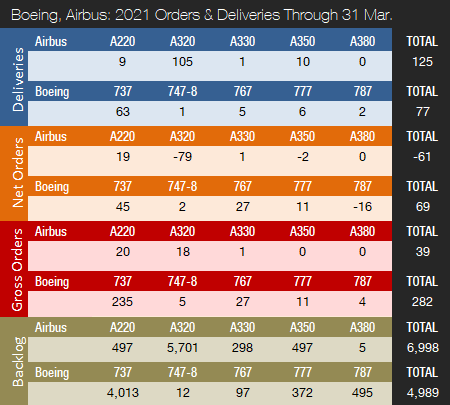

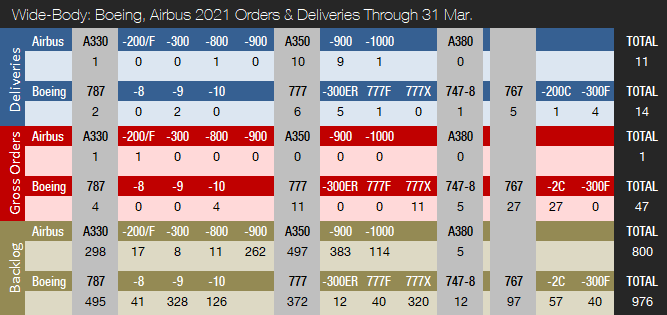
Note: The 777-300ER backlog includes one 777-200LR.
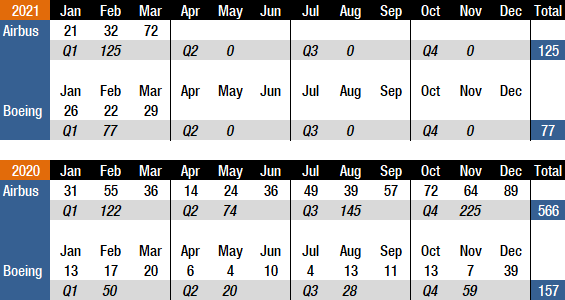
References:
- https://www.forecastinternational.com/platinum.cfm
- http://www.boeing.com/commercial/#/orders-deliveries
- https://www.airbus.com/aircraft/market/orders-deliveries.html
- https://www.airbus.com/newsroom/press-releases/en/2021/01/airbus-updates-production-rates-in-response-to-market-environment.html
- https://boeing.mediaroom.com/2021-04-13-Boeing-Announces-First-Quarter-Deliveries
- https://www.swamedia.com/releases/release-82cbf944d0e782c7bbd20a72257499a3-southwest-airlines-adds-100-firm-orders-for-the-boeing-737-max-7
- https://boeing.mediaroom.com/news-releases-statements?item=130843
- https://boeing.mediaroom.com/2021-01-27-Boeing-Reports-Fourth-Quarter-Results
- https://www.cnet.com/news/boeing-737-max-8-all-about-the-aircraft-flight-ban-and-investigations/
Forecast International’s Civil Aircraft Forecast covers the rivalry between Airbus and Boeing in the large airliner sector; the emergence of new players in the regional aircraft segment looking to compete with Bombardier, Embraer, and ATR; and the shifting dynamics within the business jet market as aircraft such as the Bombardier Global 7000, Cessna Hemisphere, and Gulfstream G600 enter service. Also detailed in this service are the various market factors propelling the general aviation/utility segment as Textron Aviation, Cirrus, Diamond, Piper, and a host of others battle for sales and market share. An annual subscription includes 75 individual reports, most with a 10-year unit production forecast. Click here to learn more.

Based in Denmark, Joakim Kasper Oestergaard is Forecast International’s AeroWeb and PowerWeb Webmaster and European Editor. In 2008, he came up with the idea for what would eventually evolve into AeroWeb. Mr. Oestergaard is an expert in aerospace & defense market intelligence, fuel efficiency in civil aviation, defense spending and defense programs. He has an affiliation with Terma Aerostructures A/S in Denmark – a leading manufacturer of composite and metal aerostructures for the F-35 Lightning II. Mr. Oestergaard has a Master’s Degree in Finance and International Business from the Aarhus School of Business – Aarhus University in Denmark.
A military history enthusiast, Richard began at Forecast International as editor of the World Weapons Weekly newsletter. As the Internet grew in importance as a research tool, he helped design the company's Forecast Intelligence Center and currently coordinates the EMarket Alert newsletters for clients. Richard also manages social media efforts, including two new blogs: Defense & Security Monitor, covering defense systems and international issues, and Flight Plan, which focuses on commercial aviation and space systems. For over 30 years, Richard has authored the Defense & Aerospace Companies, Volume I (North America) and Volume II (International) services. The two books provide detailed data on major aerospace and defense contractors. He also edits the International Contractors service, a database that tracks all the contractors involved in the programs covered in the FI library. More recently he was appointed Manager, Information Services Group (ISG), a new unit that encompasses developing outbound content for both Forecast International and Military Periscope.



